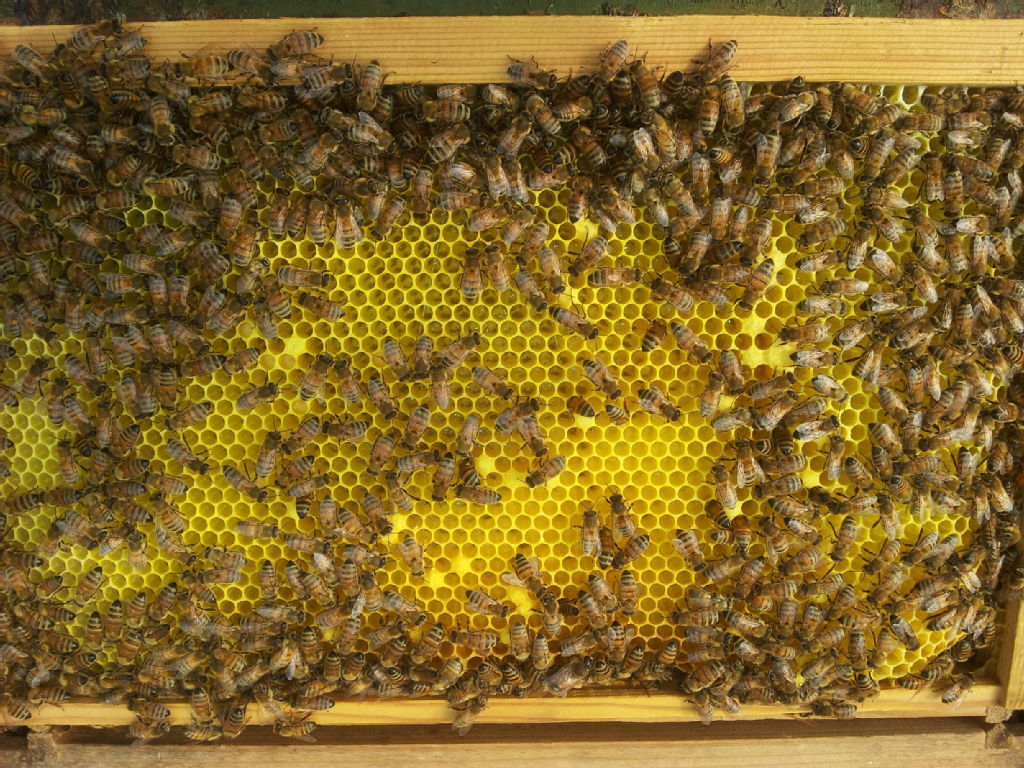Investigating the spread of pests and pathogens in honeybees in the UK and abroad
My first two-year project at Warwick involved investigating the spread of infection within honeybee populations in the UK. The work a combination of mathematical modelling, statistical fitting and computer simulations, with a particular emphasis on Monte Carlo Markov Chain (MCMC) schemes for the determination of parameters. Preliminary work focused on an epidemic of American foulbrood (AFB) on the island of Jersey during the summer of 2010. A rigorous likelihood-based analysis was carried out to derive parameters and likely infection times. A spatial SIR model with underlying owner network was then constructed to validate the parameters and to test different management strategies for reducing the size of the epidemics. A paper detailing these results has recently been published (see Publications).
Subsequent work, and the overall aim of the project, was to model the spread of European foulbrood (EFB) and AFB across the UK. Data was made available from 1994 through to 2012, with information such as the source of bee imports and the cause of inspections known. Using the framework from the work on Jersey, we hope to increase understanding about the nature of EFB and AFB transmission dynamics, and how to limit the spread of these diseases. The conclusions drawn could then be extended to tackle future pathogens which may become endemic. My project supervisors were Professor Matt Keeling and Dr. Jim Bull (Swansea).

Honeybees depositing sunflower nectar on a honeycomb.
Credit for image: Giles Budge, National Bee Unit, the Food and Environment Research Agency (FERA).
We were recently awarded a 1-year grant by DEFRA, to work with FERA and Swansea University to investigate novel and exotic pests of honeybees. Dr. Daniel Franklin (formerly a Ph.D. student in the WIDER group) worked on the project over May 2014 - April 2015, and rapid progress was made in calibrating models for new invasive pests based upon previous honeybee epidemics in the UK (in particular the varroa outbreak of the early 1990s). We have published two manuscripts based on data of an Asian hornet outbreak in southwest France, and modelling the spread of Asian hornet (as it recently reached the UK). We have also published work on optimising the locations of sentinel apiaries in the UK, strategically placed to pick up novel pests and pathogens if and when they arrive in the UK.
The small hive beetle (Aethina tumida, or SHB for short) was accidentally imported to Italy in 2014 (in the southern region of Calabria), and the Italian authorities have been attempting to stop the spread of SHB further through the country. I was an expert panel member of the European Food Safety Authority (EFSA) working group on SHB, whose remit was to understand the spread of SHB thus far, and to highlight actions that can be taken to limit its dispersal within and outside of Italy. The opinion was recently published in the EFSA journal (see Publications). The modelling work that has been done is currently being written up into an additional manuscript.

The spread of Asian Hornet in Andernos-les-Bains, in France, in the period 2007-2014.
Taken from: Franklin et al., 'Invasion dynamics of Asian hornet, Vespa velutina (Hymenoptera: Vespidae): A case study of a commune in south-west France', Applied Entomology and Zoology (2017).
Relevant publications
- Lloyd A. C. Chapman, Chris P. Jewell, Simon E. F. Spencer, Lorenzo Pellis, Samik Datta, Rajib Chowdhury, Caryn Bern, Graham F. Medley and T. Déirdre Hollingsworth (2018), 'The role of case proximity in transmission of visceral leishmaniasis in a highly endemic village in Bangladesh', PLOS Neglected Tropical Diseases (accepted).
- Matthew J. Keeling, Daniel N. Franklin, Samik Datta, Mike A. Brown and Giles E. Budge (2017), 'Predicting the spread of the Asian hornet (Vespa velutina) following its incursion into Great Britain', Nature Scientific Reports 7, no. 6240. [ARTICLE]
- Daniel N. Franklin, Mike A. Brown, Samik Datta, Andrew G. S. Cuthbertson, Giles. E. Budge and Matt J. Keeling (2017), ‘Invasion dynamics of Asian hornet, Vespa velutina (Hymenoptera: Vespidae): A case study of a commune in south-west France’, Applied Entomology and Zoology 52(2), 221-229. [ARTICLE]
- Matthew J. Keeling, Samik Datta, Daniel N. Franklin, Ivor Flatman, Andy Wattam, Mike Brown and Giles E. Budge (2017), 'Efficient use of sentinel sites: detection of invasive honeybee pests and diseases in the UK', Journal of the Royal Society Interface 14(129), no. 20160908. [ARTICLE]
- EFSA panel (2015), 'SHB spread, survival and establishment', EFSA Journal 13(12), 4328 [77 pp.]. [ARTICLE]
- Samik Datta, James C. Bull, Giles E. Budge and Matthew J. Keeling (2013), 'Modelling the spread of American foulbrood in honeybees', Journal of the Royal Society Interface 10(88), no. 20130650. [ARTICLE]

Contact details
Address:
Room A2.48,
Allen Building,
NIWA,
301 Evans Bay Parade,
Hataitai.
Wellington 6021,
NEW ZEALAND.
Tel: +64 43 860 522
E-mail: s.datta@warwick.ac.uk
